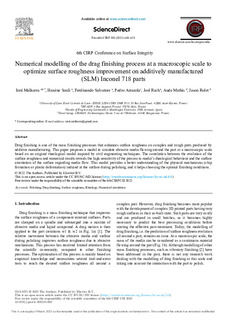Title
Numerical modelling of the drag finishing process at a macroscopic scale to optimize surface roughness improvement on additively manufactured (SLM) Inconel 718 partsAuthor
Author (from another institution)
Other institutions
Université de LyonIRT M2P
Naval Group CESMAN
Version
Published version
Rights
© 2022 The Authors. Published by Elsevier B.V.Access
Open accessPublisher’s version
https://doi.org/10.1016/j.procir.2022.01.002Published at
Procedia CIRP. Vol. 108. N. C. Pp. 648-653, 2022Publisher
Elsevier B.V.Keywords
Polishing
drag finishing
surface roughness
Rheology ... [+]
drag finishing
surface roughness
Rheology ... [+]
Polishing
drag finishing
surface roughness
Rheology
Numerical simulation [-]
drag finishing
surface roughness
Rheology
Numerical simulation [-]
Abstract
Drag finishing is one of the mass finishing processes that enhances surface roughness on complex and rough parts produced by additive manufacturing. This paper proposes a model to simulate abrasive me ... [+]
Drag finishing is one of the mass finishing processes that enhances surface roughness on complex and rough parts produced by additive manufacturing. This paper proposes a model to simulate abrasive media flowing around the part at a macroscopic scale based on an original rheological model inspired by civil engineering techniques. The correlation between the evolution of the surface roughness and numerical results reveals the high sensitivity of the process to media’s rheological behaviour and the surface orientation of the surface regarding media flow. This model provides a better understanding of the physical mechanisms (chip formation or plastic deformation) induced at the surface during polishing, and it helps choosing the optimal finishing conditions. [-]
Collections
The following license files are associated with this item:























